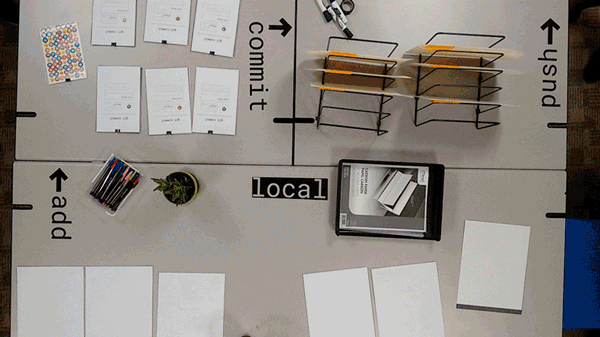This summer I did a research fellowship at the Library Innovation Lab, or LIL for short, and I enjoyed it immensely! Part of the Harvard Law School Library, LIL is a mixture between a start-up and design studio, staffed with a bunch of multi-talented developers, lawyers and librarians, working on a range of projects, from building a public API for the Caselaw Access Project, creating, mixing and sharing open source educational content with H2O, and preventing link rot with Perma, among other fun things. This buzzing environment played host, as I joined a cohort of six fellows and three interns from the Berkman Klein Center for Internet & Society.

what I looked at
The project I worked on during the fellowship naturally followed from my masters project, in which I created a modular, open-source digital edition of Katarina Kelsey’s artists’ book Antigone Notes on GitHub.
During the fellowship, I studyed version control systems, praticularly git, and its pervasive use and application across various contexts and practices unrelated to source-code management. I became interested in the ways that git is appropriated by artists, designers, librarians, archivists, conservators, writers, academics and other non-technical users. The use cases that I encountered ranged from version controlling physical sculptures in a gallery setting, capturing and visualising the process of creating a zine, documenting best practices for conserving media art and the acquisition of software-based art, restoring early 1990s web artworks, crowdsourcing cooking recepies, travel advice, transcriptions and translations, collaborating on writing and cataloguing, blogging, notetaking, hosting and publishing DIY’s, design styleguides, elements, templates, typefaces, drawing tools, books and academic papers, to name a few.
These examples highlight the utility of version control in the work of a much broader spectrum of knowledge workers. The use of technology across disciplines is not necessarily something new, however, I would argue that what is new and fascinating from a librararian perspective is the important role that version control is set to play in digital information literacy. With the increasingly overwhelming amount of digital documents we create, edit and share, both for work and for leaisure, the need for efficiently managing changes and collaborating is ubiquitous. Another intriguing aspect that caught my attention is the historical developement of version control, from a component of document management systems to a stand alone open source systems designed for source code managament. Looking closely, third generation version control systems such as git integrate elements of document, records and file managaement systemes, making them a swiss-army tool for a variety of digital documents.
My project focused on increasing the awareness of version control among artists and designers and creating educational content through which to introduce non-technical audiences to git. The challenges associated with this were threefold: - create excitement about learning git - contextualise version control to their practice - tech from the ground up, with no prior knowledge or technical skills required
what I made
As a result, I developed and piloted git-physical at LIL, the first from a series of workshops through which patricipants can learn about git and its functionality by responding to creative chanllenges. In this workshop I focused on covering the basics: three-tree architecture, simple git workflow, and commands (add, commit, push). This is fairly standard for any beginners tutorial but contained a twist - the whole thing was completely analogue!

Participants engaged in a simplified version control exercise of image and text wile designing a postcard. Following the basic git workflow they took several versions of their work through git’s architecture - from the working directory, through the staging index, to the version database, as well as to a remote repository where each version was displayed. In the process the participants produced several versions of their design, each accompanied by a commit note.

Working in this way allowed participants to experience the workflow in a familiar setting and learn the basics in an interactive and social environment. By the end of the workshop everyone had ideas on how to implement git in their work and was eager to learn more.
what’s next
The responces were really encouraging so I am currently working on developing another two workshops as part of series. Keep your eyes peeled! If you want to read more about my thinking during the process of creating the workshop, you can read my guest post on LIL’s blog.